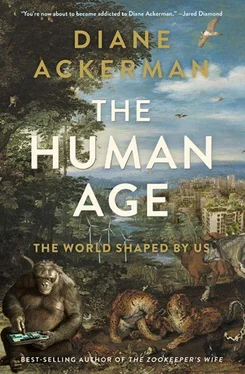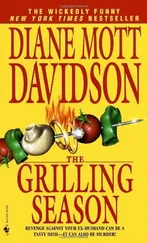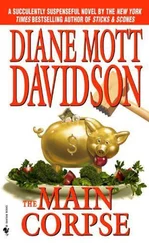The “it” is our place in the rocky bones of history. Admiring a chunk of rock on a table by Terry Jordan’s window, I lift it in my hands and peer at the embossed fossils on its surface, where ram’s-horn-shaped ammonites look like they’re butting their way out.
“This is a wonderful place for fossils,” I say. “Do you think our bones will show in the fossil record in this way, oh, say, ten million years from now?”
“Only if we’re trapped in sediment!” she says, with a slightly impish smile. Then, seriously: “Maybe people living in coastal areas like New Orleans, Tokyo, or the Netherlands, or island nations—areas that will sink and disappear in mud when the sea level rises.”
When we talk about the Age of the Dinosaur or the Age of the Trilobite, we expect to find fossils. But that’s not true in the Age of Humans. It’s not necessarily our bones that future geologists will ponder, but an altogether different kind of evidence. Not our bones but our residue will signal the beginning of the Anthropocene, a point delineated by a “golden spike”—a marker scientists pound into the rock strata to denote an internationally agreed-upon start of a geological time period. Most spikes are in Europe’s heavily studied ribbons of exposed rock, with seven golden spikes in the United States, and dozens more throughout the world.
Let’s suppose once more that we are astronauts, this time visiting Earth millions of years after humans have left to pioneer other worlds, allowing Earth to lie fallow for a spell and restore its bounty. Few signs of us remain—on the lush, overgrown surface, that is. Exposed rock and ice cores outline our story, and a future geologist—we’ll call her Olivine—is looking for “time-rock,” layers that show magnetic, chemical, climatic, or paleontological signs of the new age that we created.
From the warmth of her sky-tent tethered above what once was Patagonia, she travels the world and digs, measures, and tests, unearthing clues like shards of pottery. In sedimentary rock near the coasts, she pores over the fossil remains of cities: low-lying mazes once called Miami or Calcutta. She detects radioactive pulses from nuclear waste dumps. She finds a layer of woodland pollen suddenly replaced by agricultural pollen, and another ribbon where agriculture gave way to cities. Seams of concrete and metal abound. Scouting the oceans, she detects how, in our age, we plowed up the seabeds by bottom-trawling with large heavy nets dragged across the ocean floor, scooping up any marine life in their paths. Olivine is briefly envious. They were the first generation of humans , she thinks, with the instruments and satellites to be able to measure how geology was changing during their own lifetime. What an exciting era that must have been .
Everywhere she travels, she stumbles upon a mass of fossils of species far from their native habitats, and clumped together, on a scale unique in all of Earth’s geological history. Long before we began shuffling life forms, species invaded new lands when continents collided in slow motion. But during our geologic moment, we’ve rushed the process, and quickly surpassed plate tectonics as a rearranger of species.
Olivine smiles as she identifies rose and Scotch broom pollen in a rock sample not far from her tent, in Patagonia, once a wild and windswept frontier where armadillos roamed and the beach pebbles were jasper. Roses in Patagonia , she thinks. Those old Anthrops were rose addicts. And Scotch broom—didn’t they realize it would spread for miles? Probably transplanted by settlers . She knows the Scotch broom flailed long pokers of yellow flowers and, with weedlike momentum, colonized hundreds of acres and retuned the chemistry of the soil.
Special prizes are bits of human bones, whose DNA shows how our species began continent-jumping like hopping spiders, with some lineages predominating but most mixing, homogenizing, traveling far from their native shores, in a worldwide flux binding us all together.
She and her colleagues have argued some about the exact start of the Anthropocene—Agriculture? Industry? Nuclear bombs?—but they all agree that our world dramatically changed around the year 1800. That’s when the Industrial Revolution, powered by a massive use of fossil fuels, led to rising carbon dioxide levels. We tend to forget that the steam engine was first invented to pump water out of coal mines, and only later adapted to move boats, cars, and trains. It’s also when land clearing speeded up, and ecosystems were converted from mostly wild to mostly human-centered. Agriculture and mining became mechanized giants, spilling more fertilizer into the rivers and oceans, and more pollution into the air. The new textile mills and factory system drew laborers from the country into rapidly booming modern cities. That’s when we first began adapting the planet to us on a large scale—changing the climate, changing the oceans, changing the evolution of plants and animals.
In the process, we’ve left our signature everywhere. Our impact is already measurable in the geologic record. The rocks hum with radioactive elements from atom bomb tests of the 1960s. The fossil pollen Olivine studies in the strata will reflect how, during our epoch, the wild brew of species that once thrived for centuries on the prairies and in the forests suddenly gave way to unbroken fields of single crops—corn, wheat, soy—and vast clans of cows, pigs, and chickens.
Because plastics take so long to degrade, they, too, will show up in the fossil record. Not as flattened lawn chairs and PVC pipes, but as veins of tiny plastic tears, which is as far as plastic denatures. Quasi-crystals (crystals with orderly but nonrepeating patterns), transparent aluminum, and other newly invented forms of matter will appear in the matrix as well.
That alone is astonishing. We’re adding new elements to the sum of creation. The wide world of nature, with all its chemicals and potions, plants and animals, rocks, crystals, and metals, is not enough for us.
We’re also minting brand-new states of matter, metals no earthly eyes have ever seen—photonic clusters that can slice like light sabers, ultracold quantum gas known as polar molecules, fleecy electric, synthetic radioactive elements from einsteinium through copernicium to ununoctium, among many other artificial sprinklings. Monuments needn’t be large, or even visible to the naked eye, to declare our godlike powers. It’s one thing to rearrange bits and bobs of nature to create, say, an antibiotic or an atom bomb. But it’s quite another to cook up exotic blazons of matter, adding them like new spices to the cosmic stew. I’m amused to think of a future geologist like Olivine puzzling over weird taffylike wads, trying to figure out what chem lab sport might have spawned them.
All of these elements will ultimately show up as indisputable signs of our presence. We’re leaving tracks in the strata never seen before in Earth’s five billion years. What did you add to the fossil record today? The plastic from a six-pack or a water bottle? A midden of candy wrappers, plastic bags, and orange juice cans? Did you drive your car? If so, you’ve changed the weather by a whisker, and that, too, will ultimately add to the patterns in the rock, a legacy of our meddling from deep sea to outer space.
Monkeying with the Weather
How extraordinary that we’ve modified the whole big baggy atmosphere, where the carbon dioxide, now climbing to historic levels, is a third higher than even two hundred years ago. The synthetic fertilizers that plump up our crops churn out more nitrogen than all of the plants and microbes do naturally. Analyzing sedimentary core samples from Arctic lakes, future geologists like Olivine will see how we’ve addled the chemistry of the oceans and the air.
Читать дальше












